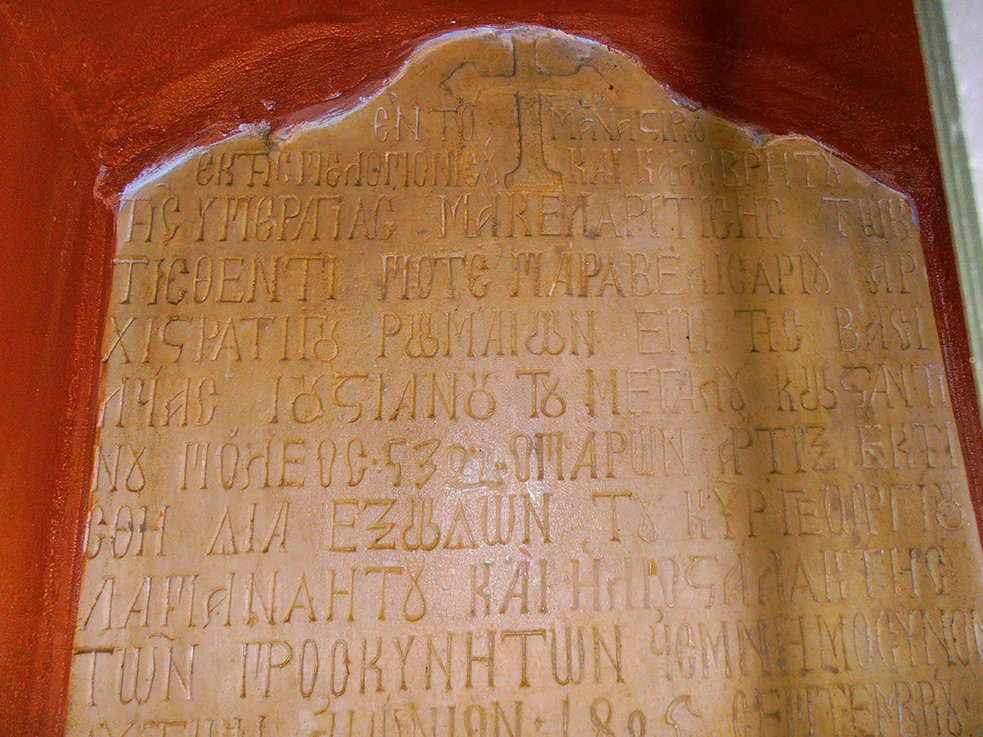
532 AD: Monastery foundation
According to tradition, the Monastery was first founded in the 6th century AD, the year 532 to be precise, at the height of the Byzantine Empire. Its Ktetor is believed to be Belisarius, Justinian’s famed general, who constructed the monastery of the Virgin Mary as a form of penance for his part in the infamous massacre of the “Nika” rioters in Constantinople. A marble inscription preserved in the narthex of the Monastery’s Katholikon reads as follows: «ΕΝ ΤΩ ΜΟΝΑΣΤΗΡΙΩ ΤΗΣ ΠΕΛΟΠΟΝΝΗΣΟΥ ΚΑΙ ΤΩΝ ΚΑΛΑΒΡΥΤΩΝ ΤΗΣ ΥΠΕΡΑΓΙΑΣ ΜΑΚΕΛΛΑΡΙΤΙΣΣΗΣ ΤΩ ΚΤΙΣΘΕΝΤΙ ΠΟΤΕ ΥΠΟ ΒΕΛΑΣΣΑΡΙΟΥ ΑΡΧΙΣΤΡΑΤΗΓΟΥ ΡΩΜΑΙΩΝ ΕΠΙ ΤΗΣ ΒΑΣΙΛΕΙΑΣ ΤΟΥ ΙΟΥΣΤΙΝΙΑΝΟΥ ΤΟΥ ΜΕΓΑΛΟΥ ΚΩΝΣΤΑΝΤΙΝΟΥΠΟΛΕΩΣ ΤΩ 532» (“The Monastery of the Holy Theotokos Makellaritissa in Kalavrita, Peloponnese, erected by Belisarius, General of the Romans, in the reign of Justinian the Great of Constantinople, in 532”).
Originally, the monastery was built below the outcrop on which it currently sits.
1458: Destruction of the Monastery by the Turks
In the wake of the fall of Constantinople in 1453, Mehmed II the Conqueror brought fire and the sword to mainland Greece. On 15 May 1458, he conquered Corinth. His troops stormed the Peloponnese. Fleeing for their lives, the locals sought refuge in the Monastery of Makellaria.
Ottoman forces under Kati-Pasha laid siege to the Monastery from the adjacent fortified position of “Katikampos”. They were met by the Greek warchief Giannos and his forces, which had fortified themselves at a place known as “Giannou- kampos”. These locations were named after the leaders of the opposing forces, names they retain to the present day. The Ottomans, reinforced by troops under Voivod Pasha, stormed the Voivodorachi position, overcame the dogged resistance from the Monastery and Giannos’ warriors and slaughtered monk and civilian alike. It’s said that so much blood was spilled that the monks’ cells were filled with it. The Monastery assumed its present name of Makellaria from the words aima-kellia (blood and cells respectively) or from the Italian word macellio (massacre).
Originally, the monastery was built below the outcrop on which it currently sits. According to historical sources, it was rebuilt in a different position after it was sacked by the Ottomans in 1458.

1700: Transfer of the Monastery to the rock
Τhe surviving monks wanted to rebuild the monastery, but not where it once stood as they were concerned about the prevailing weather conditions, especially the strong winds that rip through the area. Instead, they constructed the new monastery in a part of a cave sheltered from the wind, where the chapel of the Transfiguration currently stands.
Labourers came from the local villages, especially from Lapanagoi, to help in the construction.
Inexplicably however, any progress the labourers would make during the day would be undone come nightfall, with those arriving for the morning shift being met with piles of rubble and missing tools and materials.
A few days later the tools were found at the summit of the outcrop were the Monastery currently stands. Overriding the protests of the foreman (who considered the location unsuitable due to the local weather conditions), the monks began to clear out the rock and lay the foundations for the new Monastery as indicated by the Virgin Mary. Up high, in a natural depression of the rock –still visible in the holy Bema of the single-nave Basilica of the Dormition of the Theotokos– the monks discovered a clay vessel filled with congealed oil next to an icon of the Virgin Mary.
But the foreman insisted. While the monks were clearing out space to lay the foundations, he stubbornly continued to build the monastery in the cave of the Transfiguration. But at the precise moment when the icon of the Virgin Mary was discovered, the construction scaffolding collapsed, taking the labourers working on them and their tools and sweeping them into the Selinountas river gorge. Save for the foreman, nobody was hurt. The monks anointed the injured foreman withe the oil they had found and sat in prayer. Miraculously, he experienced immediate recovery from his injuries and, in gratitude for the protection the mother of God had provided him, he was convinced to construct the monastery at the divinely indicated location, encountering none of the previous misfortunes in the process.
1784-1805: Monastery renovation
The first renovation took place in 1784 by the hieromonk Neophytos with the assistance of locals from the surrounding areas. A Nun named Vartholomea, is also reported as helping the work of the hieromonk Neophytos. The second renovation was carried out in 1805 by Georgios Lapanagitis. This time a narthex was built as an addition to the Μonastery's katholikon, as indicated on the marble slab: “ὁ παρῶν ἄρτιξ ἐκτίσθη δι’ ἐξόδων τοῦ Γεωργίου Λαπαναγίτου καὶ τῆς Ἠλιοστάλακτης τῶν προσκυνητῶν εἰς μνημόσυνον αὐτῶν αἰώνιον 1805, Σεπτεμβρίου 1” (this narthex was built by expenses incurred by Georgios Lapanagitis and by pilgrims of the Virgin Mary in eternal memoriam thereof, 1 September 1805).
During this renovation, a human chain of the residents of Lapanagoi transferred the foundation stone for the new buildings of the Monastery from a depth of 150 metres to its current location. Furthermore, new monks' cells were built, while at the same time devout Christians donated Gospels to the Monastery, icons, habits, silver oil lamps and vasa sacra, vineyards, fields, sheepcotes, olive groves, each their name “εἰς μνημόσυνον αἰώνιον” (in eternal memoriam).
1790-1825: Renamed as Makellaria
As tradition has it, the Monastery was initially known as the Virgin Mary Lithariotissa or Lithostrotiotissa. The following tradition is associated with how it assumed the name of the Virgin Mary Makellaria.
When the Monastery fell to the Ottomans, the Hegumen begged their commanders to spare the monastery as it was the site of innumerable miracles attributed to the Virgin Mary. Incredulous, the Ottoman Pashas demanded that the Hegumen demonstrate his claims and prove the miraculous powers of the Virgin Mary. He replied that he would throw the lampion that lit the miraculous icon of the Virgin Mary off the cliff into the Selinountas river gorge. The Ottoman commanders agreed that if it landed upright without losing so much as a drop of its lamp oil, they would spare the Monastery. True to their word, they dispatched men into the gorge to confirm the Hegumen’s claim. The lampion was then thrown from the cliff and lo! The miracle had occurred. The Ottoman soldiers discovered the lampion stuck among the branches of a tree but entirely sound and unbroken. Having been convinced of the miraculous powers of the Virgin Mary, they spared the monastery. Some time afterwards, Turkish troops, among whom there were participants in the first conquest who had witnessed the miracle firsthand, revisited the monastery. Those soldiers who know of the miraculous powers of the Virgin Mary were adamant that the monastery should be spared, while their compatriots insisted that it ought to be destroyed. The disagreement between the two groups became so heated and partisan that they went for each-others’ throats, resulting in a massacre in the Monastery courtyard from which it took its name (Makellaria).
1915: Decline of the Monastery
After the death of the last 5 hieromonks, i.e. in 1915, the Monastery started to decline. When the late Timotheos was Metropolitan of Kalavryta and Aigialia, for reasons yet unknown, the Monastery was first annexed to the Monastery of Agios Nikolaos of Vlasia and then to the Monastery of Taxiarches as a metochion (dependency). At this time, the real estate of the Monastery was sold, the sheep and goats were scattered and the Monastery was left unattended and unsupervised, and as a result, destroyed.
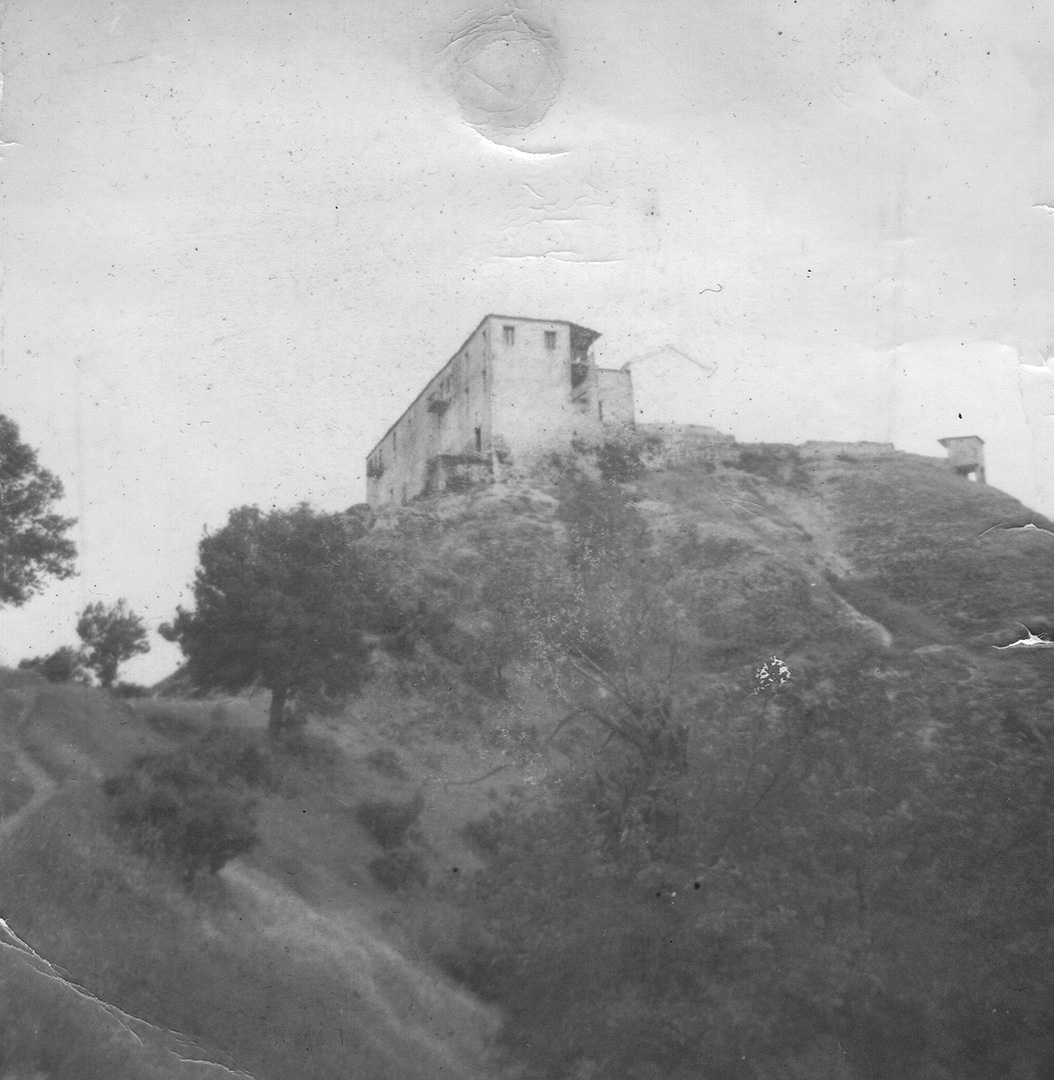
1949 - 1955: 3rd Renovation of the Monastery
Upon the appointment of Metropolitan Agathonikos in the Province of Kalavryta and Aigialia, a visit to the Monastery was enough to sadden him once he saw the condition it was in.
In his effort to find a suitable person to staff the Monastery, he sent there monk Agathangelos Mitsioulis, a monk of Agia Lavra who came from Larissa, whom he ordained a deacon and appointed him Hegumen of the Monastery, which by that time he had already restored to its independent status, by Royal Decree.
A committee is appointed, made up by: 1) Konstantinos Karpetas, Doctor, 2) Georgios Adamopoulos, father’s name: Ioannis , 3) Andreas D. Mourtzouchos, 4) Spyridon Vlemmas, father’s name: Ioannis, 5) Vasilios A. Vagenas, former residents of Lapanagoi and then of Aigio and Chr. G. Vagenas, resident of Lapanagoi. They also received Ministry approval to conduct a fundraiser which took place in all villages of the province of Aigialia.
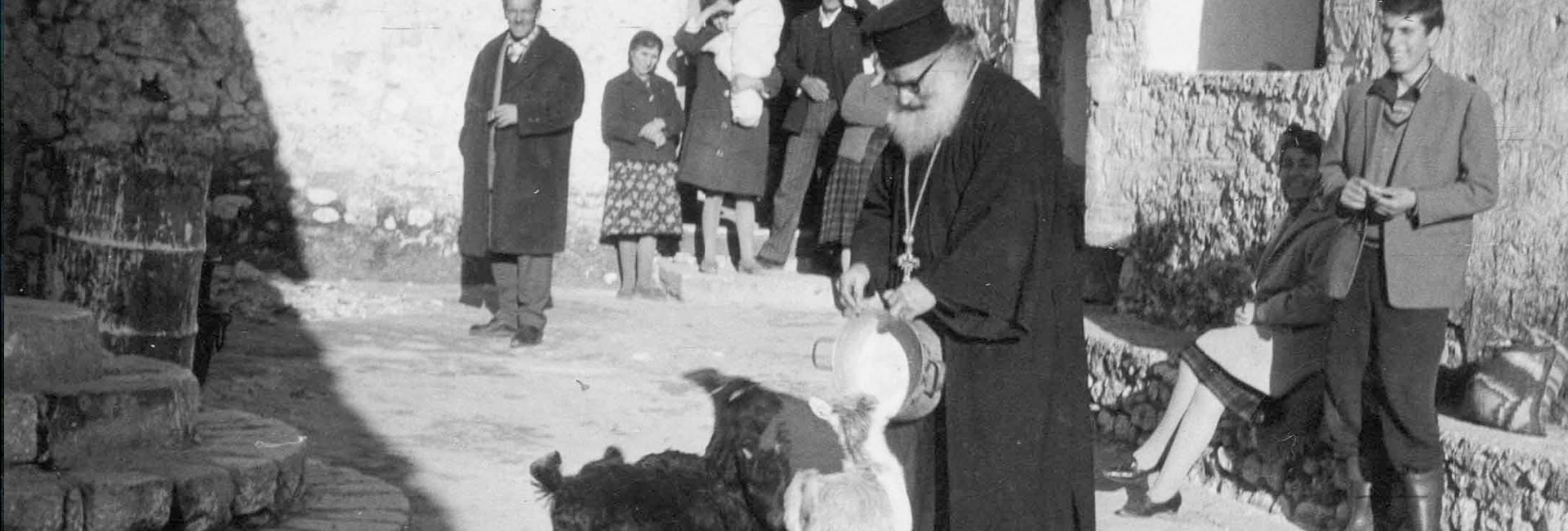
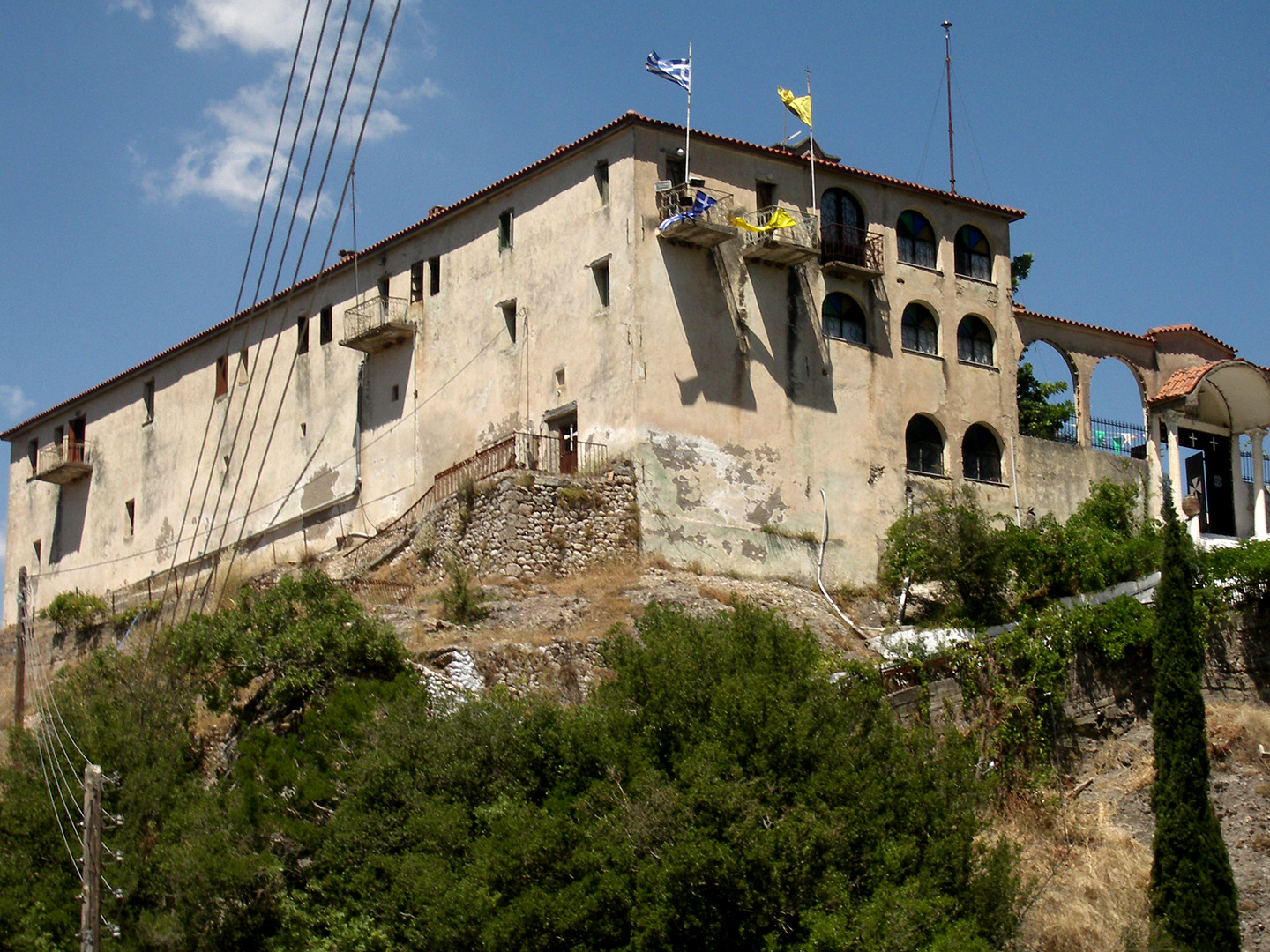
1970-1990
Given the old age of Hegumen Agathangelos, the title of the Hegumen soon passes to the monk of Mega Spilaio Monastery, archimandrite Anthimos Dritsas. The Monastery flourished, was manned by several monks, and a small expansion was added to the buildings of the Monastery. During his rule, many pilgrims came to the Monastery and miracles were performed through the Grace of the Virgin Mary. Unfortunately, soon locals opted to leave the province and the surrounding villages due to the rise of urbanisation and the incentives given for moving to cities. This made living in the Monastery extremely difficult and resulted in its closure and the migration of its monks to other Monasteries.
1990-2011
Given the great number of miracles in the Monastery and the massive attendance of the faithful, especially during the summer months, the Monastery continued to operate on Sundays of the summer months by a committee consisting of: Archpresbyter Christos Frantzis, Archpresbyter Georgios Stroumboukis and Archpresbyter Dimitrios Liakopoulos.
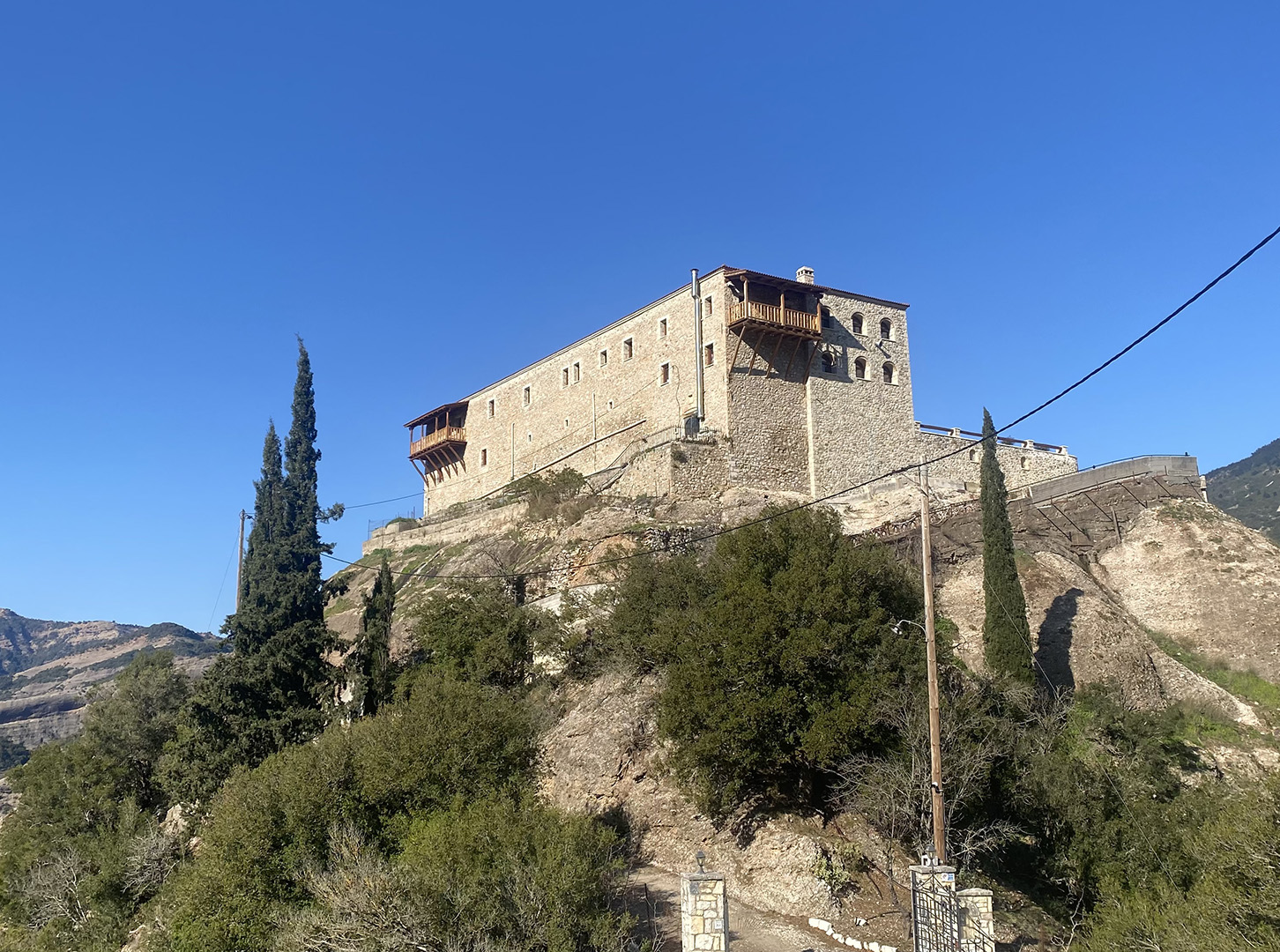
2011 - Today
Since its foundation, the Monastery has been male, but since 1990 it has not had a fraternity. As of July 2011, with the blessing of His Eminence the Metropolitan of Kalavryta and Aigialia, Amvrosios, a women's fraternity took over and continued its work with the blessing of His Eminence the Metropolitan of Kalavryta and Aigialia, Ieronimos. During these years, the women's fraternity has completely renovated the building facilities of the Monastery, with the help of devout pilgrims and donors.

